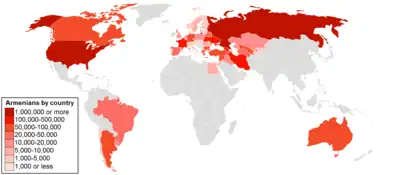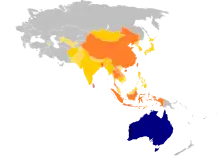| Total population | |
|---|---|
| 16,723 (by ancestry, 2011)[1]
50,000—60,000 (estimates)[2][3] | |
| Regions with significant populations | |
| Sydney and Melbourne | |
| Languages | |
| Armenian, Arabic, Russian and Australian English | |
| Religion | |
| Majority Armenian Apostolic Church, Armenian Catholic Church, Armenian Evangelical Church and Protestantism | |
| Related ethnic groups | |
| Armenian Americans |
| Part of a series on |
| Armenians |
|---|
 |
| Armenian culture |
| By country or region |
Armenian diaspora Russia |
| Subgroups |
| Religion |
| Languages and dialects |
|
| Persecution |
Armenian Australians refers to Australians of Armenian national background or descent. They have become one of the key Armenian diasporas around the world and among the largest in the English-speaking world.
While the Armenian community in Australia is relatively recent compared to other Armenian diasporas, Australia's economic prosperity over the last couple of decades has attracted many skilled Armenian migrants. The official relationship between Australia and Armenia started on 26 December 1991, and diplomatic relations were established on 15 January 1992.[4]
Overview
The influx of Armenians into Australia has come from many different Diaspora countries; these countries include Armenia, Egypt, Iran, Lebanon, Syria, Jordan, Israel, Turkey, Ethiopia, and India.[4]
Today the Australo-Armenian community includes members born in up to and over 43 different countries. The main concentration of Armenians in Sydney are in the City of Ryde (12,000 – 15,000) followed by City of Willoughby[5] and City of Warringah. Smaller communities exist in Adelaide, Brisbane, and Perth.
Organisations
All traditional Armenian diaspora parties have established in the country:
- Social Democratic Hunchakian Party[6]
- Armenian Democratic Liberal Party
- Armenian Revolutionary Federation
There are also many associated political groupings like:
Other operating social and cultural organisations within the Armenian Australian community:
- Armenian General Benevolent Union
- Hamazkayin Regional Committee breaking down into sub-divisions/committees.[9][10]
- SBS Armenian Radio[11]
- Armenian Chamber of Commerce in Australia[12]
- Homenetmen Australia[13]
- Hye Hoki[14]
- Cultural centres
In Sydney there are several main cultural centres to which Armenians gather, one located in Willoughby, New South Wales named the Armenian Cultural Centre and another located in Bonnyrigg, New South Wales[15] named the Armenian Cultural Panoyan Centre, and smaller Cultural Centres in Neutral Bay, City of Ryde, Frenchs Forest (Ararat Reserve) and Naremburn, Sydney. Melbourne also has several cultural centres.
Education
Armenian is an accepted language in the NSW HSC. Also known as Armenian Continuers, the course is taught at Saturday schools or as a subject at full-time Armenian schools.
Armenian Schooling has become stronger throughout the Australian community with two full-time schools operating in Sydney. These are:
Alongside which a number of Saturday schools operate as listed below:
Religion
The oldest and largest Armenian church in Australia and throughout the world[19] is the Armenian Apostolic Church, which in Australia is led by Archbishop Haigazoun Najarian who is the Primate of the Australian and New Zealand Armenian Apostolic churches and replaced Archbishop Aghan Baliozian. The Armenian Catholic community is led by Father Parsegh (Basil) Sousanian. there is also a presence of the Armenian Evangelical Church in Sydney and Melbourne in addition to the Holy Trinity Armenian Brotherhood Church and the Armenian Evangelical Brethren Church, both in Sydney.[20]
- The Armenian Apostolic Church is located in Chatswood, New South Wales.[21]
- The Armenian Apostolic Church of Holy Trinity in Wentworthville, New South Wales.
- The Armenian Catholic Church is located in Lidcombe, New South Wales.[22]
- The Armenian Evangelical Church can located in Willoughby, New South Wales.
- The Armenian Brotherhood Holy Trinity Church is located in Ryde, New South Wales.[23]
- The Armenian Evangelical Brethren Church is located in Northbridge, New South Wales.[24]
Notable Armenian Australians
The Australian Armenian community has produced many notable figures who have become key members who shape the identity of Armenians in Australia. Below are a few of these members.
- Gladys Berejiklian – former Member of NSW Parliament, Treasurer, Premier of New South Wales.[25]
- Vic Darchinyan – Three-division world champion boxer
- George Donikian – Network Ten news presenter
- Brian Goorjian – Regarded as Australia's most successful basketball coach.
- Slava Grigoryan – classical guitarist, two time ARIA winner.
- Jano Toussounian – Australian/Armenian actor
- Joe Hockey (Armenian father's surname was "Hokeidonian" before he arrived in Australia) – Member of Federal Parliament – Treasurer. Ambassador of Australia to the United States of America from 2016
- John Kachoyan – Director and writer
- Yurik Sarkisian – Olympic Silver medalist and two time World Champion weightlifter, set 17 world records during his career.
See also
References
- ↑ The People of Australia – Statistics from the 2011 Census (PDF). Australian Government. 2014. ISBN 978-1-920996-23-9. Archived from the original (PDF) on 14 July 2014.
- ↑ "Armenian National Committee of Australia: Community". Armenian National Committee of Australia. Retrieved 31 October 2021.
- ↑ "Diaspora – Australia". Office of the High Commissioner for Diaspora Affairs. Retrieved 31 October 2021.
- 1 2 "Armenia country brief". Department of Foreign Affairs and Trade. July 2015. Retrieved 25 December 2015.
- ↑ Julito Briones (21 May 2007). "A report about Sydney". Home.people.net.au. Archived from the original on 30 August 2019. Retrieved 26 December 2015.
- ↑ "Social Democrat Hunchakian Party – Australian Leadership". hunchak.org.au. Retrieved 25 December 2015.
- ↑ "Armenian Youth Federation of Australia". Ayfaustralia.org. Retrieved 25 December 2015.
- ↑ "Armenian National Committee of Australia". Anc.org.au. Retrieved 25 December 2015.
- ↑ "Galstaun College Armenian Primary & Secondary School". Galstaun.nsw.edu.au. Retrieved 25 December 2015.
- 1 2 "Hamazkaine Nairi and Homenetmen Ararat Sydney Chapter". Ararat.org.au. Retrieved 25 December 2015.
- ↑ "Armenian – SBS Your Language". Sbs.com.au. 12 November 2015. Retrieved 25 December 2015.
- ↑ "Australian Armenian Chamber of Commerce". Aacca.com.au. Retrieved 25 December 2015.
- ↑ Homenetmen Australia Regional Website
- ↑ "Hyehoki". hyehoki.com. Archived from the original on 8 June 2009. Retrieved 25 December 2015.
{{cite web}}: CS1 maint: unfit URL (link) - ↑ Armenian Info & Portal Web Site
- ↑ "Galstaun College, Ingleside NSW – Sydney Armenian Primary & Secondary School". Galstaun.nsw.edu.au. Retrieved 25 December 2015.
- ↑ "Calendar". Alexander Primary School. Archived from the original on 26 February 2021. Retrieved 1 September 2013.
- ↑ "Alex Manoogian Armenian Language School". Archived from the original on 18 May 2014. Retrieved 1 September 2013.
- ↑ Armenians#Religion
- ↑ "Australian Standard Classification of Religious Groups (ASCRG), 1996". Australian Bureau of Statistics. 21 April 2006. Retrieved 25 December 2015.
- ↑ "The Armenian Apostolic Church". CNEWA. 23 November 2015. Retrieved 25 December 2015.
- ↑ "Our Lady Of The Assumption". armeniancatholic.org.au. Retrieved 25 December 2015.
- ↑ This page contains addresses of all Armenian Brotherhood Churches Around the World
- ↑ "Armenian Evangelical Brethren Church". Armenianbrethren.org. Retrieved 25 December 2015.
- ↑ "The Hon. Gladys Gladys Berejiklian, BA, DIntS, MCom MP". Parliament of New South Wales. 19 May 2015. Archived from the original on 24 December 2015. Retrieved 25 December 2015.
External links
- http://www.agbu.org.au
- http://www.aacca.com.au/
- http://www.ararat.org.au/
- http://www.nareg.com.au/nas/
- http://armenianchurchsydney.org.au
- http://www.anc.org.au/
- http://www.ayfaustralia.org
- ↑ According to the local classification, South Caucasian peoples (Azerbaijanis, Armenians, Georgians) belong not to the European but to the "Central Asian" group, despite the fact that the territory of Transcaucasia has nothing to do with Central Asia and geographically belongs mostly to Western Asia.

